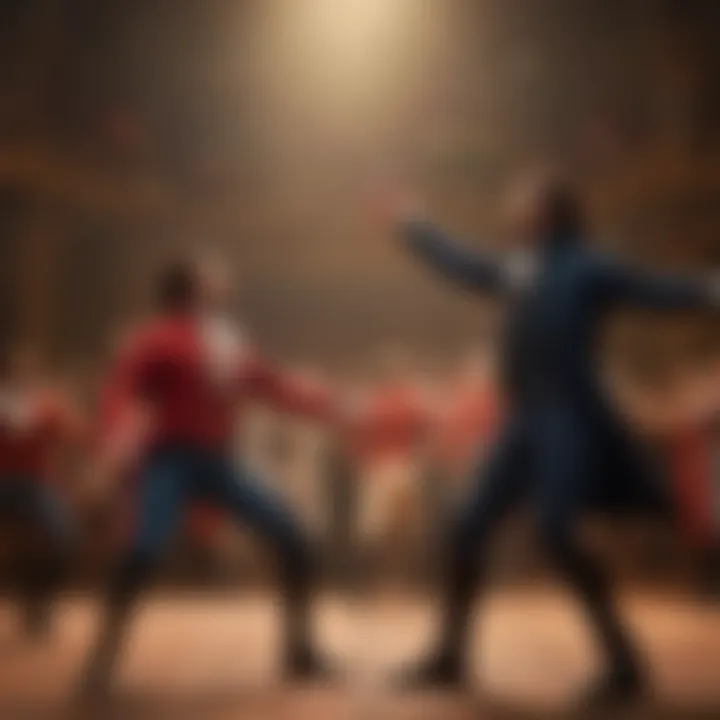The Complex Legacy of Hamilton: A Musical Reimagined


Intro
"Hamilton" is not just a musical; it’s an intricate tapestry woven with the threads of history, individuality, and cultural evolution. This groundbreaking production has transformed the landscape of Broadway by infusing it with elements of hip-hop, making history relatable, accessible, and, dare I say, downright engaging. At its core, this performance doesn’t merely recount the rise and fall of Alexander Hamilton, but rather it propels the audience into the very heart of America’s founding principles while mirroring contemporary societal issues.
In this article, we'll embark on a deep dive into the multiple layers that compose "Hamilton", examining its themes, character portrayals, and historical context. Our aim is to uncover how a modern retelling of a 18th-century figure can spark discussions that resonate with today’s audience. Buckle up as we explore the intersection of history, music, and narrative in a way that leaves no stone unturned.
Preface to Hamilton
The Broadway musical Hamilton has become more than just a stage production; it’s a cultural phenomenon that has sparked discussions across various domains. It intricately weaves the historical narrative of Alexander Hamilton, one of America's Founding Fathers, with modern musical storytelling. Understanding this musical's introduction is vital as it sets the ground for dissecting its deeper themes and implications.
The way Hamilton presents history invites audiences to think critically about its relationship with contemporary politics and identity. It showcases a multifaceted view of American heritage, where the complexities of ambition, love, betrayal, and the struggle for change come to life through dynamic performances. This musical serves as a vehicle for both historical education and cultural introspection, prompting us to reflect on how stories shape our understanding of self and society.
Overview of the Musical
Hamilton debuted on Broadway in 2015, capturing audiences with its innovative blend of hip-hop, R&B, and traditional musical elements. Its narrative is not merely about reciting facts from history; it's a reinterpretation that breathes new life into the past. The character of Alexander Hamilton, played by Lin-Manuel Miranda, is a remarkable driving force behind this expression.
The musical consists of 46 songs that span Hamilton's life, depicting his rise from obscurity to prominence. Musicians like Daveed Diggs, Leslie Odom Jr., and Phillipa Soo also bring historical figures to life, offering rich performances that resonate with the audience. The choreography and staging are visually captivating, ensuring every scene is a feast for the senses. This artistic approach enhances the emotional weight of the lyrics and helps in conveying a complex narrative that not only entertains but educates.
In weaving together personal ambition with national history, Hamilton challenges traditional narratives, asking the audience to consider whose stories are told and whose are left out. The use of diverse casting speaks to themes of representation and inclusivity, further broadening the scope of who can see themselves in America's founding story.
Historical Background of Alexander Hamilton
To appreciate Hamilton, it's crucial to grasp who Alexander Hamilton was and why his life matters. Born on the Caribbean island of Nevis in 1755, Hamilton faced numerous hurdles from a young age. He was orphaned and lived in poverty, yet he possessed a fierce intellect and an unyielding ambition. His journey to the United States and subsequent rise to power as the first Secretary of the Treasury is remarkable, underscoring themes of resilience and determination.
Hamilton's contributions to the establishment of the American financial system cannot be understated. He laid the foundation for modern economics and was a staunch advocate for a strong federal government. Understanding these aspects of his life offers insights into his motivations and the labor behind his ambitious policies.
The historical context of Hamilton’s life is pivotal when interpreting the musical. The era he lived in was rife with political tension and revolutionary fervor. By highlighting his struggles and triumphs, Hamilton contextualizes not only the man but also the vibrational pulse of the nation at that time.
Moreover, his infamous rivalry with Thomas Jefferson, alongside his complex relationships with key figures such as George Washington and Aaron Burr, illustrates the political landscape of the early United States. These historical dynamics enrich the musical’s narrative, making it more than a performance—it transforms it into a lens through which we can understand America’s past and its ongoing evolution.
The Narrative Structure
The narrative structure of Hamilton isn't just a setting for the musical; it serves a pivotal role in shaping how the audience engages with the story. It’s a seamless amalgamation of historical events wrapped with rich characterizations, inviting the viewer to explore nuances of a historical figure through a contemporary lens. This approach makes the complex life of Alexander Hamilton more relatable, showing that personal and political ambitions intertwine in ways that resonate even today. This innovative storytelling method speaks to the heart of Hamilton and propels it beyond mere entertainment—it turns it into a lively historical document.
Chronological vs. Non-Chronological Storytelling
Hamilton employs a non-chronological storytelling method in which events are presented more thematically or by significance rather than strictly in the order they occurred. This allows for a more profound exploration of the themes of legacy, ambition, and conflict, which are remarkably relevant to the human experience today. For instance, instead of following a straightforward timeline, we witness past events juxtaposed against present ones. The outcome creates a rich tapestry that emphasizes the cyclical nature of ambition and its consequences.
The use of non-linear narrative keeps the audience on its toes while unveiling critical moments in Hamilton's life. The brilliance lies in how these shifts ignite curiosity, giving scenes an added layer of emotional depth. Think of it as mixing the past with the present—much like the blend of hip-hop and show tunes that characterizes the score itself. With surprising twists and turns, the audience is compelled to reevaluate their perceptions of Hamilton and the founding era.
Character Arcs and Development
Character development is the lifeblood of Hamilton. Each character undergoes a transformation, whether it be in ideals or reality. Alexander Hamilton, portrayed as both ambitious and flawed, becomes a conduit through which the audience can examine the relentless pursuit of legacy. The portrayal of other key figures, such as Aaron Burr, Eliza Hamilton, and George Washington, unfolds layers of human complexity. This non-simple painting of characters reveals how deeply personal jealously, love, and loyalty intertwine with historical happenings.
The effectiveness of character arcs in Hamilton lies in their ability to complicate our understanding of historical heroes. For instance, Hamilton's fierce ambition stands the test of time, while Burr's more cautious approach leads to a tragic rivalry, making the ultimate duel not just a clash of swords, but ideologies.


This development is spiced up with raw emotions and poignant moments, urging listeners to connect with characters on a personal level. It orchestrates a beautifully chaotic blend of desires, disappointments, and decisions that mirrors the human condition, far surpassing the limitations of a mere historical recount.
"History is written by the victors," a popular saying suggests, but Hamilton reminds us that both the triumphs and the losses deserve a voice in the narrative.
Through this carefully structured narrative, Hamilton breathes life into history, prompting deeper questions about legacy, ambition, and the impact of individual choices on the broader societal canvas.
Key Themes in Hamilton
The themes within Hamilton are not merely decorative; they provide the framework of the narrative, shaping both character motivations and the overall impact of the story. These themes, tightly woven into the fabric of the musical, offer insight into timeless human experiences. In the following sections, we explore key themes such as ambition and legacy, love and betrayal, as well as revolution and change, each contributing to a richer understanding of Alexander Hamilton's life and the world he inhabited.
Ambition and Legacy
Ambition drives many of the characters in Hamilton, most notably the titular figure himself. Alexander Hamilton’s relentless pursuit of success reflects the broader American ethos of hard work and determination. This ambition is portrayed not just as a personal strength but also as a double-edged sword. Hamilton climbs the social ladder but, in doing so, alienates friends and family. The lyrics suggest that while ambition can lead to creating a legacy, it often comes at a considerable cost.
One powerful moment encapsulates this in the song "My Shot":
"I’m not throwin’ away my shot!"
This simple phrase represents more than just Hamilton's desire to succeed; it embodies the hope and tenacity of a young nation. The drive for accomplishment resonates with the audience, reflecting common aspirations and the often harrowing emotional toll they exact. Legacy in Hamilton is portrayed as something that intertwines with risking personal relationships, showing how the pursuit of one's goals can dictate one’s narrative long after they are gone.
Love and Betrayal
The theme of love intermingled with betrayal offers a complicated emotional landscape within Hamilton. Relationships are depicted in shades of complexity, illustrating how love can be both a haven and a battleground. Alexander and Eliza's romance begins as a passionate union but soon experiences strain from Hamilton's ambition and infidelity.
In the poignant musical number "Burn," Eliza expresses her heartbreak after learning of Hamilton's affair with Maria Reynolds. Here, we witness the power of betrayal as it unfolds—Eliza feels not only personal pain but also the weight of public humiliation. This moment highlights how personal choices impact broader narratives of trust, integrity, and vulnerability.
Through Eliza's journey, the audience understands that love is fragile, often challenged by circumstances beyond one's control. The duality of love's strength and vulnerability offers a powerful lens through which to view the human experience, especially in relation to historical figures whose personal lives have shaped their legacies in profound ways.
Revolution and Change
Revolution and change stand as a cornerstone of the Hamilton narrative, reflecting the transformative period of early American history. The story of Hamilton is ultimately one of upheaval—the American Revolution is not just a backdrop but rather an integral part of the characters’ lives. This theme communicates a sense of urgency and the necessity for progress, mirroring the challenges society faces today.
Hamilton, alongside his compatriots, is depicted not only as a soldier but as a visionary whose ideas about governance and finance forge a new path for the fledgling nation. The song “The Room Where It Happens” exemplifies the negotiations and compromises that define political change, demonstrating that revolution is often messy and reliant on dialogue among diverse perspectives.
The emphasis on revolution extends beyond the literal to encompass personal transformations as well. Characters grow and evolve throughout the musical, learning that change is not just about grand gestures but also about everyday choices and moral dilemmas. This reflection is particularly poignant in the current sociopolitical climate, where the ongoing struggle for equity and justice continues to resonate with audiences.
Each of these themes in Hamilton intertwines, ultimately defining the narrative's impact on both the characters and the audience. By unpacking these dimensions, we can better appreciate the musical not just as a form of entertainment but as a cultural artifact that encapsulates key human experiences.
The Role of Music and Lyrics
The music and lyrics in Hamilton serve as the backbone of the entire production. They not only propel the narrative forward but also enhance the emotional depth of the characters and the themes explored throughout the show. From the moment the overture begins, audiences are thrust into a world where hip-hop meets Broadway, blending various musical genres that reflect the complexity of the era and the personalities involved.
The Fusion of Musical Genres
One of the most striking features of Hamilton, is its masterful blending of genres. The music encapsulates everything from classic show tunes to rap, R&B, and even elements of pop. This fusion serves multiple purposes:


- Accessibility: By utilizing hip-hop, Lin-Manuel Miranda taps into a wider cultural narrative, inviting younger audiences to engage with historical content in a fresh way. As a result, Hamilton isn't just seen as a musical but as a cultural phenomenon.
- Narrative Energy: The quick pace of rap songs like "My Shot" gives urgency to Alexander Hamilton's ambitions, contrasting with slower ballads that explore more introspective moments. This deliberate shift in musicality allows the audience to feel the tension and excitement in real time.
- Diversity in Sound: By mixing genres, Hamilton mirrors the diversity of American society. Different musical styles reflect the varied backgrounds and experiences of the characters, enriching the storytelling.
In a way, the music of Hamilton serves as an additional character, one that carries the weight of the narrative and allows for moments of levity as well as poignancy. This approach encourages an examination of American history from different angles, appealing to a broad spectrum of theatergoers.
Lyricism and Storytelling
The lyrics in Hamilton are a standout feature, showcasing Lin-Manuel Miranda's innately poetic sensibility. Each word is chosen with precision, and the intricate wordplay often reveals deeper meanings and thematic connections. Some key considerations about the lyricism include:
- Character Voice: Each character’s perspective is uniquely expressed through their lyrics. For instance, the contrasting styles in Hamilton’s ambitious verses and Thomas Jefferson’s more laid-back melodies highlight their differing personalities and perspectives.
- Historical References: Miranda embeds historical quotes, anecdotes, and references in the lyrics, allowing for a seamless integration of education with entertainment. This has opened pathways for discussions surrounding historical accuracy and interpretation among audiences and educational institutions alike.
- Emotional Impact: Songs like "It’s Quiet Uptown" convey profound grief and forgiveness through poignant lyrics. The emotional weight of these lines resonates deeply, often leaving audiences in contemplative silence.
"The music of the revolution is the music of storytelling itself. In Hamilton, every beat contributes to the tale of ambition, love, and strife that defined a nation."
This ability of lyricism to connect deeply with audiences transcends the mere act of recounting history; it breathes life into figures long past, making their struggles and triumphs palpable today.
Representation and Diversity
The topic of representation and diversity stands as a cornerstone in the realm of contemporary theater, and Hamilton is no exception. By consciously choosing to cast actors of color in roles that historically represented white figures, Hamilton shakes up traditional norms in theater. This decision is not merely a superficial aesthetic change; it holds profound implications for societal perception and the narratives told within this pivotal musical.
Casting Choices and their Implications
Casting choices in Hamilton have sparked discussions that extend well beyond the stage. By employing a racially diverse cast to portray key historical figures, the musical sends a powerful message about inclusivity. Lin-Manuel Miranda, the creator, consciously chose to break the mold and challenge the status quo. He shifted the lens through which audiences view history—instead of being left to believe that only white actors can play iconic figures, we see a reflection of America today.
Each color-blind casting decision fosters a renewed sense of ownership over history for people of different ethnic backgrounds. The significance is palpable. For instance, when we see a Black actor portraying George Washington, it not only prompts audiences to reassess their understanding of these figures but also suggests that these stories belong to all Americans. This representation fosters a deeper connection with historical context, encouraging reflection on how diverse voices contribute not only to musical narratives but also to America's historical dialogue.
"Representation isn't just a token gesture; it’s about creating spaces that reflect the world we live in."
This has also led to discussions about the implications of such choices. Critics argue that the casting can sometimes gloss over the complexities of the actual historical figures' lives and contextual realities. However, Miranda himself has expressed a desire to spark conversation, which he certainly does; the musical becomes a springboard for debates on race, representation, and historical accuracy. In a country as diverse as the United States, this representation is a step forward, albeit part of a much larger journey.
Impact on Modern Theater
The success of Hamilton has left an indelible mark on modern theater, encouraging productions to adopt similar casting methods. It has shifted the focus onto the importance of representation in artistic expressions, prompting producers, writers, and directors to rethink their approaches to storytelling. Diversity in casting is now seen as essential rather than optional, pushing boundaries in a traditional space that often mirrored historical elitism.
Moreover, Hamilton has set the stage for a dialogue about who gets to tell stories and how those stories get told. This is especially crucial when considering narratives that extend beyond the mainstream. The impact has led to increased opportunities for minority actors and artists, widening the scope of what's possible in theater.
Epilogue of this Section
In essence, Hamilton confronts the critical issues surrounding representation and diversity head-on, forging a path that many contemporary theater productions are beginning to follow. The conversations spawned by this musical continue to resonate, reminding us that the stage is not just a place for performance but a platform for change and inclusivity. By exploring these themes, it underscores the necessity for a more integrated approach to narrating history—a true reflection of the people who live it.
Cultural Impact of Hamilton
The cultural impact of Hamilton extends far beyond the confines of its stage. It has fundamentally altered the landscape of musical theater, reshaping expectations around storytelling, representation, and engagement with historical narratives. Its significance cannot be understated, as it invites critical dialogues surrounding issues of race, identity, and the American experience. The seamless interplay between hip-hop and Broadway music forms a bridge that connects diverse audiences, demonstrating that history can resonate across generational and cultural divides.
Influence on Popular Culture
The resonance of Hamilton within popular culture is palpable, permeating everything from social media to political discourse. The musical has given rise to a plethora of memes, references, and adaptations, showcasing how it has woven itself into the very fabric of contemporary conversation.
- Merchandising and Branding: Items like Hamilton-themed apparel, posters, and even board games have become household staples, demonstrating the musical's widespread appeal and status as a cultural phenomenon.
- Celebrity Endorsement: Prominent figures, from Barack Obama to Lin-Manuel Miranda himself, have championed the work. Their involvement has only served to bolster the musical's credibility and influence among various demographics.
- Impact on Politics: The way Hamilton addresses themes of governance and revolution has inspired discussions in academic and political spheres. This discourse connects the historical narrative to present-day issues, making it relevant for young activists and scholars alike.


Through these channels, Hamilton has become not just a musical, but a movement, influencing how stories are told and who gets to tell them. In a sense, the lyrics have become a way to speak truth to power, inviting listeners to reevaluate familiar histories through a modern lens.
Educational Value and Discussions
The educational potential of Hamilton is immense. It serves as a springboard for discussions that bridge the past with the present, arming students and educators alike with fresh perspectives. Schools across the nation have harnessed its narrative to engage students in topics like democracy, leadership, and the complexity of historical figures.
- Curriculum Development: Inspired by the musical, many educators have developed lesson plans that incorporate its themes and music into classroom discussions, allowing students to explore ideas of legacy and moral ambiguity.
- Critical Dialogues: The portrayal of Alexander Hamilton and his contemporaries prompts questions about race, identity, and power dynamics that students can dissect through critical analysis. It encourages them to dig deeper rather than accept historical narratives at face value.
- Interdisciplinary Connections: The fusion of history and art opens avenues for collaboration across subjects. A theater arts class can investigate the storytelling techniques used, while a history class examines Hamilton’s life, leading to a richer understanding of both.
Hamilton stands as a testament to the idea that art can inform, inspire, and invoke action. It creates a platform for meaningful discourse, providing educators and students with resources to discuss the complexities of America’s past and present.
"Just as the Founding Fathers shaped our country, Hamilton shapes how we think about that history today."
Critical Reception and Awards
In the realm of theater, few productions are met with the kind of fervent reception as Hamilton. The critical and commercial success of this musical is not a mere coincidence, but rather the product of a keen blend of innovative storytelling and robust musicality. Diving into the critical reception and awards is essential in understanding how this piece reshaped the landscape of contemporary theater. Not only did it elevate the narrative craft, but it also sparked discussions about representation in the arts.
Critics' Reviews and Audience Reactions
Critics across the board have lauded Hamilton for its transformative approach to American history. From the first performance, reviewers spilled ink on its captivating rhythm and engaging lyrics. Notably, Ben Brantley from the New York Times described it as not just a musical, but a "revolutionary theatrical experience." This captures a sentiment shared among many commentators: that it burst onto the scene as a fresh breath amid the sometimes stagnant air of Broadway.
Audience reactions further solidified its reputation. Fans flocked to theaters, ticket lines stretching like ribbons down the block, eager to witness the fusion of hip-hop and Broadway. Social media buzzed with excitement, as hashtags like #Ham4Ham captured the interactivity of the show's fan base. Such engagement emphasized how Hamilton was more than a performance; it became a cultural phenomenon igniting conversations on history and identity.
Moreover, the unconventional casting choices resonated with viewers, eliciting both praise and — at times — criticism. Some audiences found a deeper connection to the story through a diverse cast, while others believed that historical accuracy was compromised. This duality in response is precisely what added layers to its critical analysis. The musical bewitched audiences on a profound level but also opened up a stage for discussions regarding authenticity and interpretation in storytelling.
"Hamilton is a story of America then, told by America now," Lin-Manuel Miranda aptly articulated; this perspective undoubtedly shaped the discourse surrounding the show.
Awards and Recognitions
The accolades that Hamilton garnered are nothing short of impressive. At the 2016 Tony Awards, it swept the boards, winning 11 Tonys, including the coveted Best Musical. These accolades were not just tokens of appreciation; they signified a shift in theatrical norms and expectations.
Among its awards, Hamilton received the prestigious Pulitzer Prize for Drama, recognizing its significant impact on American theater. This award underscored its relevance in modern discussions about race, politics, and legacy.
In addition to critical acclaim, the musical racked up multiple Grammys, including Best Musical Theater Album. The distinct style of its musical composition — blending diverse genres — struck a chord with not only theatrical audiences but also music enthusiasts. Furthermore, its victory in the Drama Desk Awards reinforced its standing as a groundbreaker that set the bar for future productions.
The End
In an era where storytelling often overlooks the depth of historical narratives, Hamilton stands as a beacon of innovation and cultural significance. This musical isn’t merely a performance; it's an exploration of identity, ambition, and the complexity of the American dream. The conclusion of our analysis emphasizes how Hamilton reshapes the discourse around history and representation in theater.
Reflecting on Hamilton's Legacy
As we look back at Hamilton's impact, it’s clear that its legacy is multifaceted. The musical reimagines figures considered to be relics of the past, using modern sensibilities to make them relatable. For instance, through its diverse casting, the show presents historical characters in a way that challenges traditional narratives. This intentional choice serves as a reminder that America's story is not confined to the pages of dusty books, but filled with voices from various backgrounds.
- The use of hip-hop and R&B establishes a connection with younger audiences, fostering an appreciation for a genre that reflects their own realities.
- The dialogue around race and representation has sparked discussions in educational settings, encouraging students to rethink history.
- Furthermore, it invites conversations about who has the right to tell these stories, enhancing critical thinking and debate.
The show's ability to resonate with various demographics—kids, scholars, and casual theater-goers alike—illustrates its role in shaping contemporary cultural narratives. This legacy reminds us that history is always in the making, interpreted by new generations with fresh perspectives.
Future of Historical Musicals
Peering into the future, one might ponder: where do historical musicals go from here? The success of Hamilton lays a template for future productions that seek to blend the old with the new. It paves the way for stories that honor their origins while inviting audiences to connect with them emotionally.
- Expect to see more musicals that delve into unexplored aspects of history, particularly those that highlight marginalized figures not typically featured in standard curricula.
- The fluidity of genres means we might find even more surprising combinations that can bridge gaps between disparate musical traditions, as seen with the success of various artists and composers experimenting in this space.
- Additionally, the rise of digital platforms may amplify this trend, allowing theatrical productions to reach global audiences, fostering a communal experience that transcends geographical barriers.















